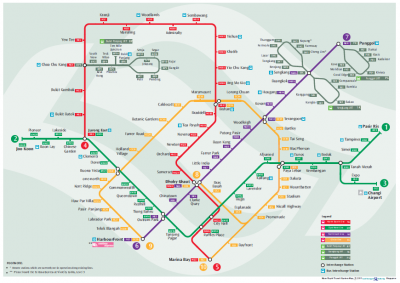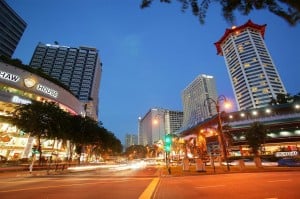Known as a tiny red dot on the world map, Singapore is a small island and much of it is accessible by land. Getting around is not difficult at all, seeing as how most parts of the island are well-connected.
Because of scarcity of land, there is a need to restrict the number of private cars on the road and car prices are significantly higher compared to other countries with only 1 in 10 residents owning a car. This translates to high car rental costs as well. As such, tourist rarely rent cars and the most popular form of travel is through Taxis. There are heaps of different taxi companies in Singapore who together put out 25,000 taxis on the road and taxi fares in Singapore are ironically relatively cheaper compared to many other developed countries.
If you would like to try out Singapore’s very well developed public transport, note that Singapore makes use of “EZ-link cards” for the 2 forms of transport have, “MRT” and Buses. EZ-link cards are available at all MRT stations and bus interchanges and allow you store your credit, and all you need to do is tap your card to pay. However, if you are only making a one-time off trip, it would be more practical to buy a single trip card (for MRT) or pay cash (for buses) instead. Just make sure you have coins for Buses as they do not accept dollar notes or provide change.
Mass Rapid Transit (MRT)
Most parts of the island are accessible via the Mass Rapid Transit, otherwise known as MRT. Travelling on the MRT is both convenient and cheap, and there’s an MRT station at almost every part of the island. A typical journey from Boon Lay MRT to Pasir Ris MRT should not cost you more than $2.00. There are also sufficient signs and maps around MRT stations to guide you around so that you don’t lose your way, and should you require any further assistance, there are also customer service counters where you may seek help. Singapore’s MRT network currently consists of the North-South Line (represented by red colour), East-West Line (represented by green colour), North-East Line (represented by purple colour) and the Circle Line (represented by orange colour). There are also Light Rapid Transit (LRT) stations to make certain parts of the heartlands in the deeper parts of Singapore more accessible to commuters, but if you are tourist you will probably will not be using LRTs.
It would also be useful to note the first and last train timings, and you can find the details at the official websites here:
Average Travel Time based on Station (PDF)
First and Last Train Timings
Bus
Bus services are also available island-wide, but research should be done beforehand if you’re planning to travel around by bus because it may be easy to get lost if one is not familiar with the roads in Singapore. Every bus stop has a signboard which states the bus services available, the exact stops which these bus services stop at as well as the first and last bus timings of these bus services, but again these may all appear too foreign for a non-local to comprehend. It would thus be advisable to do ample homework before attempting to travel around Singapore by bus.
Late night public transportation is also available on Fridays, Saturdays and eves of Public Holidays. These night buses usually operate from 12 midnight to 4:30AM, depending on the bus service. Fares range from $1.60 to $4.00, subject to your location and destination.
More information can be found here:
http://www.sbstransit.com.sg/transport/trpt_bus_niteowl.aspx
http://www.smrt.com.sg/buses/nightrider.asp
Taxi
If it is too much of a hassle to take public transport, there’s always the option to take a taxi, although many locals dislike the idea of this for the fact that it is an expensive mode of transport. Taxis are usually easily available at any time of the day and at any part of the island, though it may be common to see lesser taxis available before the peak periods as some of them may want to wait until the peak period – that’s when you will have to incur an extra charge as midnight surcharge. This is applicable everyday. In addition, if your trip starts at the city area or Marina Bay Sands from Mondays to Sundays and Public Holidays from 5.00PM to midnight, there is an additional city area surcharge of $3.00.
More details on taxi fares can be found here:
You may also wish to call for a taxi if you can’t flag one down and you are in a rush, but do note that booking charges apply. You may also make advance bookings so as not to disrupt your schedule. Most taxi drivers should understand basic English, so conversing with them should not be too big of a problem. All taxis accept cash as a form of payment, but only certain taxis accept NETS/credit card payment. If you plan to pay via NETS/credit card, do remember to check with the taxi driver beforehand to make sure he accepts payment by NETS/credit card.
Some tips while taking taxis in Singapore:
Always make sure the meter is on and running the moment you get on the cab. In Singapore it is illegal for taxi drivers to charge a standard fare; taxi fares must be charged by a meter and the flag down rate generally ranges from $3.00 to $5.00, depending on the type of taxi. Though laws are now stricter regarding illegal touts in Singapore, taxi touts still exist so it is important to notice that meters are always running when in a taxi. Taxi touts usually target foreigners or tourists as they are aware that tourists may not be as familiar with the Singapore system. This is especially rampant at Singapore Changi Airport.
You may often hear taxi drivers giving you two options to get to your destination, and they will frequently ask you which way you’d like to travel by. Always choose the expressway option; never go by small roads. Though taxi drivers are generally knowledgeable when it comes to the roads in Singapore, there are many small roads that remain foreign to taxi drivers and hence they may still lose their way. In the event that that happens, you will have to pay for the extra charges incurred while the taxi driver tries to find the correct way to your destination. Travelling by the expressway might be a slightly longer route, but at least it ensures that you get to your destination without going round and round in circles and end up having to pay a much higher fare.
Do take care of your belongings when in a taxi. The chances of retrieving your lost item after you’ve gotten down from the taxi is very low as the next passenger may find it and choose to keep it without the taxi driver’s knowledge. All taxi drivers are also told to pick up lost items and return them to the company’s Lost & Found, but cases of passengers being able to retrieve their lost items are few and far between, so it’s best not to take the risk. As should be the case wherever you are, always keep your items close to you and make sure you check that you haven’t missed anything out before you alight from the cab.

Drop us your email so you won't miss the latest news.











